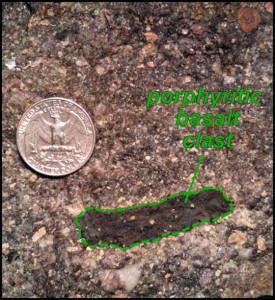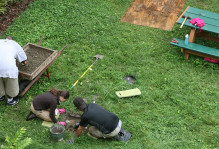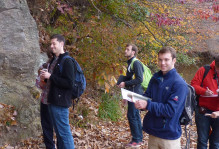Who’s unconformable (Part 2)?
It took well over a week to crawl out from under the pile of 170 final exams, a ‘gift’ delivered by my Geology 110 course, but the grading is now done and the holidays are here. This quick post draws to a close the research that my structural geology seminar completed. Recall that the seminar conducted field research in the Blue Ridge Mountains of Shenandoah National Park to determine whether the contact between the underlying greenstones of the Catoctin Formation and sedimentary rocks of the Weverton Formation is conformable or unconformable. Here is a selection from our geologic maps and cross sections.

Part of the geologic map from the structural geology seminar’s field area. Zc- Catoctin Formation, Cw- Weverton Formation, Ch- Harpers Formation. The orange line is the contact of interest for our study.

Geologic cross section illustrating the nature of the folded strata. Zc- Catoctin Formation, Cw- Weverton Formation, Ch- Harpers Formation.

Geologic map draped over the topography in Google Earth. Oblique view of the terrain, view to the south. Yellow diamonds are outcrops examined this semester.
Our research indicates that the contact is unconformable and that an interval of erosion took place after the Catoctin lava flows cooled, but before the sand and gravel of the Weverton Formation was deposited. A number of different rock types are exposed at the top of the Catoctin Formation, an observation consistent with an erosional upper contact. Clasts in Weverton sandstones and conglomerates are mostly quartz and feldspar, minerals derived from the erosion of a granite, but rare clasts of Catoctin basalt do occur and indicate that erosion of the Catoctin preceded the Weverton Formation. The unconformable boundary between these geologic units may be the product of regional uplift followed by thermal subsidence as rifting waned and the ancient North American continent broke apart some 550 million years ago. I am delighted with the research conducted by this semester’s structural geology seminar; their final work was of high quality and they’ve added another piece of understanding to the geologic puzzle that is the Appalachian Mountains.




No comments.
Comments are currently closed. Comments are closed on all posts older than one year, and for those in our archive.